Athena Review Vol. 5, no. 1
Records of Life: Fossils as Original Sources
29. Saurischian dinosaurs: Sauropods
The second group of Saurischian dinosaurs are the Sauropods ("lizard feet"). These represent some of the largest dinosaur taxa, including Diplodocus (figs.2,3), Apatasaurus, Camarasaurus, and Brachiosaurus. Many of these were herbivores. Some of the best known examples were found in the Morrison Formation, a Late Jurassic sedimentary sequence spread over a number of states in the American west (fig.1).
Morrison Formation
The Morrison Formation in the western United States contains a sequence of Late Jurassic sedimentary rocks dating from 156.3 to 146.8 million years ago (mya) spanning the Kimmeridgian and early Tithonian stages of the late Jurassic. Its layers of mudstone, sandstone, siltstone, and limestone, covering abo
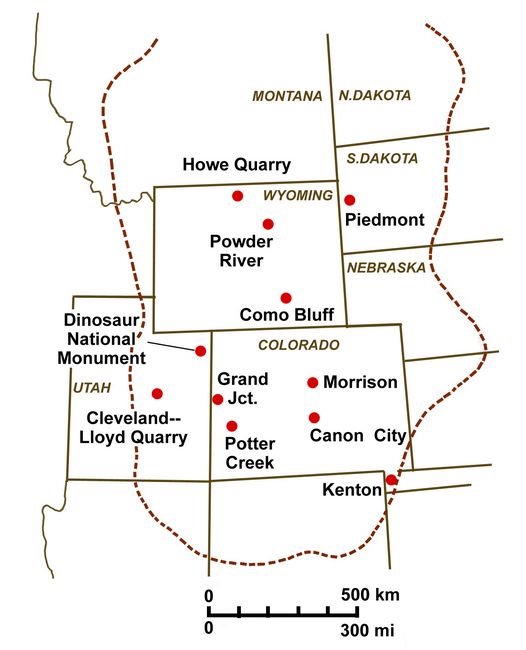 ut 600,000 square
miles (fig.1), preserve abundant fossils of animals and plants living
along Jurassic rivers and floodplains. These include many dinosaurs, for which it has been the largest source of
fossils in the Americas.
ut 600,000 square
miles (fig.1), preserve abundant fossils of animals and plants living
along Jurassic rivers and floodplains. These include many dinosaurs, for which it has been the largest source of
fossils in the Americas. The first fossils in the formation were discovered at Morrison, Colorado in 1877 by British geologist Arthur Lakes (1844-1917), who taught at the Colorado School of Mines. Lakes informed paleontologist Othniel Charles Marsh of his discovery of a dinosaur bone, and Marsh hired him to seek other fossils. Marsh was then engaged in a long-term competition known as the "Bone Wars" with the rival paleontologist Edward Drinker Cope for museum specimens of dinosaurs. Dinosaur fossils found by Lakes include Allosaurus. Stegosaurus, Apatosaurus, Camptosaurus, and Tyrannosaurus rex. In the process, he worked for both Marsh and Cope.
Fig.1: Map of the area of the Morrison Formation, and its major fossil sites (after Dunmore 1980).
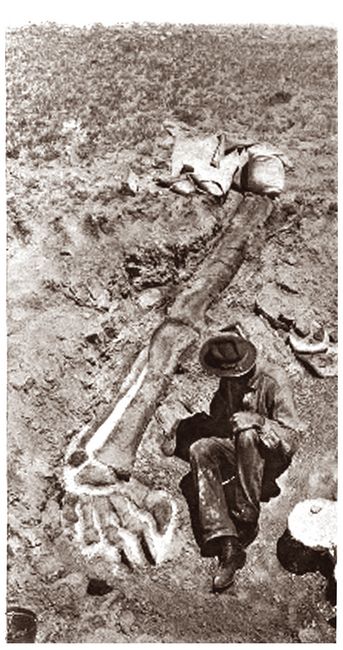
During the Kimmeridgian stage of the Jurassic (156-152 mya). the climate was relatively dry, and conifers were the dominant trees, along with ginkgos, cycads, and tree ferns, growing along rivers. Large Sauropod dinosaurs found in the Morrison Formation who fed on river bottom vegetation include Diplodocus (figs.2,3), Apatosaurus, Camarasaurus, and Brachiosaurus. Other Saurischian dinosaurs in the Formation include the therapod carnivores Allosaurus, Saurophganax, Ceratosaurus, Torvosaurus, and Ornitholestes.
The Ornithischian dinosaurs (covered in a later section) in the Morrison Formation include Camptosaurus, two species of Stegosaurus and the slightly earlier Hesperosaurus, and the early armored dinosaurs or ankylosaurs, Mymoorapelta and Gargoyleosaurus.
Diplodocus
Diplodocus was a sauropod dinosaur, a huge herbivore whose fossils were first discovered in 1877 by S. W. Williston at Cañon City, Colorado. The type fossil was named Diplodocus longus ("long double-beam") by O.C. Marsh in 1878, referring to the double-beamed chevron bones located in the underside of the tail vertebrae.
Fig.2: Rear leg bones of Diplodocus carnegii, being excavated ca.1900 at Quarry C on Sheep Creek in Albany County Wyoming, before being shipped to the Carnegie Museum in Pittsburgh (photo ca, 1900).
The most famous example, Diplodocus carnegii, was discovered in Wyoming in 1899-1900. It is one of the longest known dinosaurs, with a total length of 24 meters, including a long, whip-like tail composed of about 80 vertebrae. Their forelimbs were slightly shorter than their hind limbs, resulting in a largely horizontal posture (fig.4).
Hatcher (1901), who reassembled the Diplodocus skeleton for the
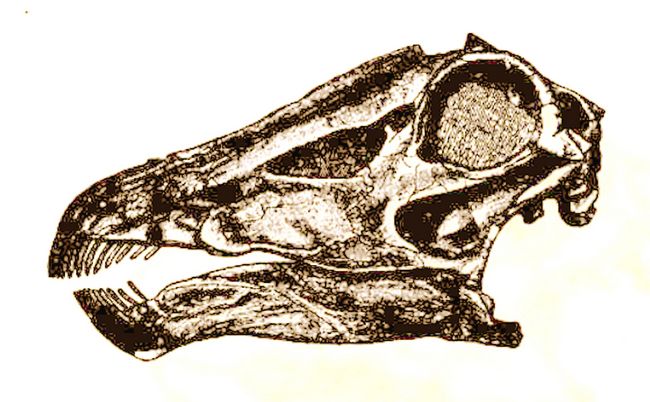 Carnegie Museum, believed it to be partly aquatic due to the
probable riverine environment. As Hatcher reports, the skull of D. carnegii was unfortunately missing. Based on the skull of D. longus (fig.3), the skulls of diplodocids were very small with a small braincase. Diplodocus
had small, peg-like teeth that pointed forward and were only present in
the front sections of of the jaws. The neck was composed of at least 15
vertebrae and may have been held parallel to the ground and unable to
be elevated much past horizontal.
Carnegie Museum, believed it to be partly aquatic due to the
probable riverine environment. As Hatcher reports, the skull of D. carnegii was unfortunately missing. Based on the skull of D. longus (fig.3), the skulls of diplodocids were very small with a small braincase. Diplodocus
had small, peg-like teeth that pointed forward and were only present in
the front sections of of the jaws. The neck was composed of at least 15
vertebrae and may have been held parallel to the ground and unable to
be elevated much past horizontal.Fig.3: Skull of Diplodocus longus (after J.B. Hatcher 1901, Pl. II; US National Museum).

Fig.4: Skeleton of Diplodocus carnegii (after J.B. Hatcher, 1901, Carnegie Museum).
Apatosaurus
Apatosaurus ("deceptive lizard") was a large herbivorous sauropod from the Late Jurassic period, dating from 152- 151 mya, during the late Kimmeridgian to early Tithonian ages. Apatosaurus, one of the largest dinosaurs, had an average length of 21–22.8 m (69–75 ft), and is classed in the same family as Diplodocus, the Diplodocidae. Marsh named the first-known species, A. ajax, in 1877, based on a nearly complete skeleton (now in the Yale Peabody Museum) discovered in the eastern foothills of the Rocky Mountains in Gunnison County, Colorado. A second species, A. louisae, was discovered and named by William H. Holland in 1916.
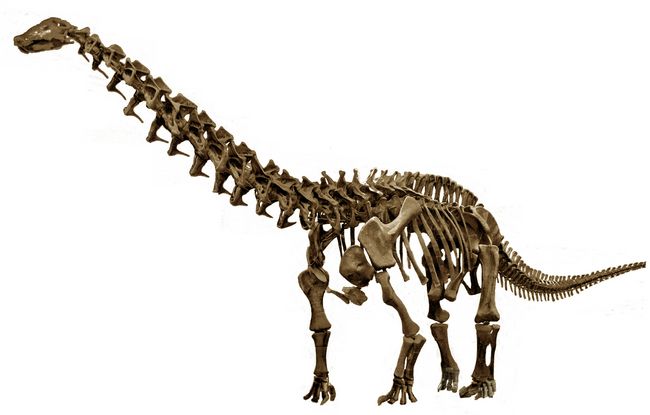
Fig.5: Skeleton of Apatosaurus, formerly labelled as Brontosaurus (American Museum of Natural History).
Apatosaurus was named "deceptive lizard" owing to the vertebral chevron bones, unlike those of other dinosaurs but similar to those of mosasaurs, large marine mammals from the Late Cretaceous. Apatosaurus was a generalized browser that likely held its head elevated. The vertebrae of Apatosaurus were lightened by internal air sacs, as in Camarasaurus. Apatosaurus fossils have been found in the Morrison Formation of Colorado, Oklahoma, New Mexico, Wyoming, and Utah.
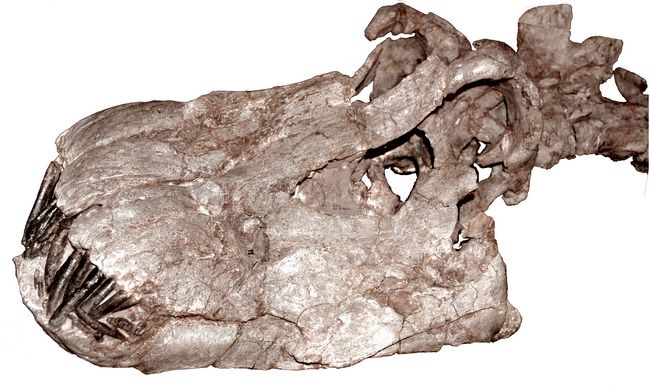
Apatosaurus was called Brontosaurus ("thunder lizard") by H.F. Osborn, a curator at the American Museum of Natural History who rejected the taxa designation by Marsh. Although Brontosaurus (first named in 1879) was by then known to be a synonym for the earlier genus name Apatosaurus, Osborn, labeled the exhibit at the AMNH (fig.6) as Brontosaurus. Through its popular exposure in the museum, Brontosaurus became one of the world's best known dinosaurs, even though its correct name was Apatosaurus.
Fig.6: Skull of Apatosaurus ajax, from the Brushy Basin Member of the Morrison Formation (Barett et al. 2011; Cincinnati Museum of Natural History & Science, CMC VP 7180)
The skull of Apatosaurus (fig.6) was often confused with that of Camarasaurus and Brachiosaurus until 1909, when the holotype of A. louisae was found, The Apatosaurus skull is more similar to that of Diplodocus, both being notably small in relation to overall body size. The snout of Apatosaurus and similar diplodocoids is squared, and the jaws are lined with spatulate or chisel-like teeth suited to an herbivorous diet.
The braincase of Apatosaurus is well preserved in a few specimens, showing a morphology similar to those of other diplodocoids. Some skulls of Apatosaurus have been found still in articulation with their teeth. Those teeth that have the enamel surface exposed show few if any scratches on the surface.
Camarasaurus
Camarasaurus ("chambered lizard") was a Jurassic plant-eating dinosaur, and among the most abundantly found sauropod dinosaurs in the Morrison Formation in Colorado, Utah, and Wyoming. Camarasaurus is grouped into
 three species which lived in the Late Jurassic period (155 -145 mya). C. supremus, the largest species, first discovered in 1877, reached a maximum length of 23 m. A second species, C. grandis, was also discovered in 1877. The most common species, C. lentus, first found in 1889, was about 15 m long as an adult. The skeleton of a juvenile C. lentus (fig.8), now in the Yale Peabody Museum, was found in 1890 in Como Bluff, Wyoming, dating from about 150 mya.
three species which lived in the Late Jurassic period (155 -145 mya). C. supremus, the largest species, first discovered in 1877, reached a maximum length of 23 m. A second species, C. grandis, was also discovered in 1877. The most common species, C. lentus, first found in 1889, was about 15 m long as an adult. The skeleton of a juvenile C. lentus (fig.8), now in the Yale Peabody Museum, was found in 1890 in Como Bluff, Wyoming, dating from about 150 mya. Fig.7: Skull of Camarasaurus lentus (Utah Natural History Museum, cast)
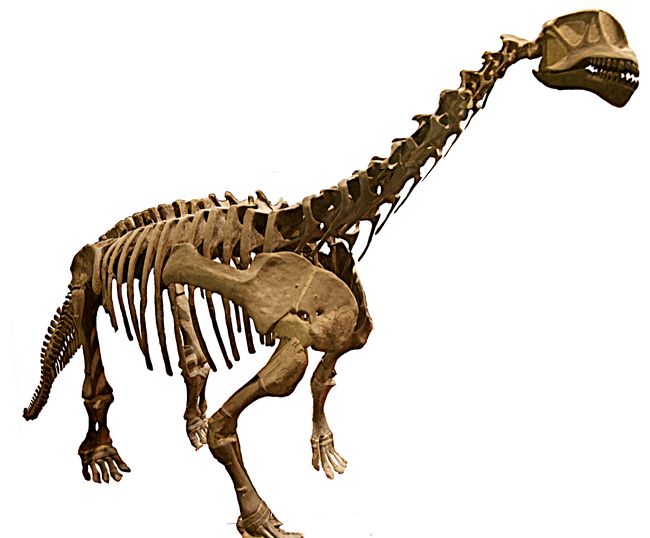
Camarasaurus had a squarish-shaped skull (fig.7) with large openings and short, robust jaws. It had large, chisel-shaped teeth up to 19 cm long, suitable for eating tough plants.
The name Camarasaurus refers to large paired openings in the neck and truck vertebrae which are called pleurocoels. These pneumatic openings were air sacs connected to the lungs, and served to lighten the weight of the skeleton, facilitating the extension of the neck for reaching tree leaves and other edible plants. The front limbs had five toes, with the inner toe having a large, sharpened claw.
Fig.8: Skeleton of a juvenile Camarasaurus lentus (Yale Peabody Museum; photo: Athena Review
Brachiosaurus
Brachiosaurus ("arm lizard") was a saurapod dinosaur in the Late Jurassic period, firs
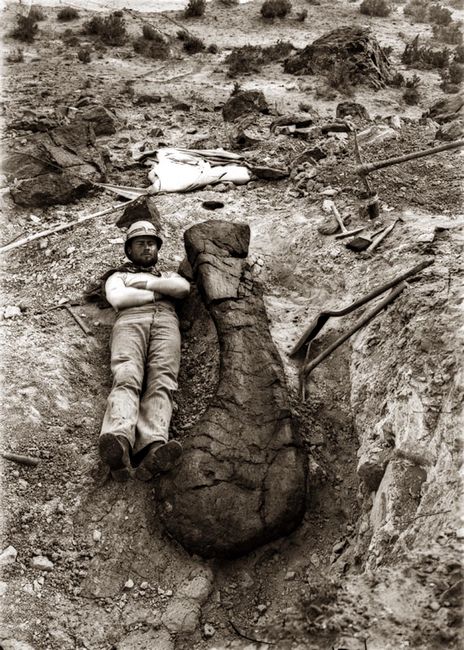 t
found in western Colorado. Brachiosaruus is one of the rarer sauropods of the Morrison Formation and some of its anatomy is still partly unclear.
A partial postcranial skeleton discovered in 1900 in the valley of the
Colorado River near Fruita, Colorado provided the type specimen. It was found
in the Brushy Basin Member of the Morrison Formation, which is
late Kimmeridgian in age (154-153 mya).
t
found in western Colorado. Brachiosaruus is one of the rarer sauropods of the Morrison Formation and some of its anatomy is still partly unclear.
A partial postcranial skeleton discovered in 1900 in the valley of the
Colorado River near Fruita, Colorado provided the type specimen. It was found
in the Brushy Basin Member of the Morrison Formation, which is
late Kimmeridgian in age (154-153 mya). Discovery began with a huge humerus or upper arm bone found by Harold Menke (fig.9), asistant to Elmer S. Riggs from the Field Columbian Museum (now the Field Museum of Natural History) of Chicago. The expedition, originally in search of Eocene mammals, now began exposure of one of the largest known dinosaur fossils.
Fig.9: Brachiosaurus altithorax humerus, shown with Riggs’ assistant Harold Menke lying beside it (photo: Elmer Riggs, The Field Museum in Chicago, 1900)
Riggs (1903) named the dinosaur Brachiosaurus altithorax for its long arms, and deep chest. Like other sauropods, Brachiosaurus was very large,
 measuring 18-21 meters (59 - 69 ft) long with a
disproportionately long neck and small skull. Brachiosaurus had longer forelimbs than hindlimbs, which resulted in a
steeply inclined trunk, and a proportionally shorter tail. It lived by
cropping vegetation as high as nine meters (30 ft) off the ground.
Unlike other sauropods, it was unsuited for rearing on its hindlimbs.
measuring 18-21 meters (59 - 69 ft) long with a
disproportionately long neck and small skull. Brachiosaurus had longer forelimbs than hindlimbs, which resulted in a
steeply inclined trunk, and a proportionally shorter tail. It lived by
cropping vegetation as high as nine meters (30 ft) off the ground.
Unlike other sauropods, it was unsuited for rearing on its hindlimbs.Fig.10: Brachiosaurus dorsal vertebrae, sacrum, ilium, and ribs of the type specimen, as found at Dinosaur Quarry No. 13 near Grand Junction, Colorado. (Photo: Elmer S. Riggs, 1904)
The skull of Brachiosaurus is best known from an example found at Felch Quarry in
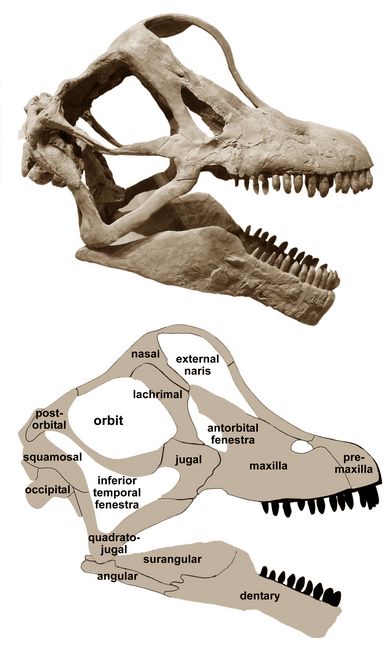 Colorado (fig.11). This skull
was about 81 cm long from the occipital condyle at the back of the
skull to the front of the premaxillae, making it the largest
sauropod skull from the Morrison Formation. The snout was somewhat
blunt. The skull fenestra or openings used for muscle attachments were large, perhaps due to the force imparted there by the massive jaw adductor muscles.
Colorado (fig.11). This skull
was about 81 cm long from the occipital condyle at the back of the
skull to the front of the premaxillae, making it the largest
sauropod skull from the Morrison Formation. The snout was somewhat
blunt. The skull fenestra or openings used for muscle attachments were large, perhaps due to the force imparted there by the massive jaw adductor muscles.The premaxilla appears to have been longer than that of Camarasaurus, and created a longer snout. The dentaries or lower jaw bones were robust, though less than in Camarasaurus. Each maxilla had space for about 14 or 15 teeth, and contained replacement teeth that had rugose enamel, similar to Camarasaurus, but with larger teeth. Each dentary had space for about 14 teeth.
Brachiosaurus is related to several sauropod taxa found in East Africa and Europe, which are considered part of the Brachiosauridae family and which provide more examples for anatomical comparisons. These include Giraffatitan, found before World War II in Geman East Africa (now Burundi and Tanzania), and Lusotitan from Portugal.
Fig.11: Brachiosaurus sp. skull, with bones labelled, found at Felch Quarry, Colorado (USNM 5730; after Carpenter 1998).
References:
Barret, P.M., G.W. Storrs, M.T. Young & L.M. Witmer. 2011. A new skull of Apatosaurus and its taxonomic and palaeobiological implications. p. 5 in 59th Annual Symposium of Vertebrate Palaeontology and Comparative Anatomy, Abstracts of Presentations, Lyme Regis, Dorset, UK, September 12th-17th 2011.
Carpenter, K. 1998 . Preliminary description of a Brachiosaurus skull from Felch Quarry 1, Garden Park, Colorado . Modern Geology 23 (1–4): 69–84..
Foster, John 2007. Jurassic West: The Dinosaurs of the Morrison Formation and Their World. Indiana University Press. ).
Hatcher, J.B. 1901 Diplodocus Marsh– Its Osteology, Taxonomy, and Probable Habits, with a Restoration of the Skeleton. Memoirs of the Carnegie Museum, Volume 1, Number 1
Riggs, E.S. (1904). Structure and relationships of opisthocoelian dinosaurs. Part II. The Brachiosauridae. Geological Series (Field Columbian Museum) 2 (6): 228–255. Popular Science Monthly Volume 67 (1905)
Glossary